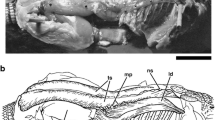Abstract
The skeleto-musculature of the metathorax and first abdominal segment was studied in representatives from all ’symphytan’ families. Forty-three informative characters were coded and scored. The distribution of character states are discussed with reference to recent cladistic treatments of the Hymenoptera. Previously unreported autapomorphies for the Hymenoptera are the separation of the metathoracic trochantins from the metepisterna and metacoxae, the position of the metafurca anteriorly on the discrimenal lamella of the metathorax and the presence of second abdominal sternum (S2)-metacoxal muscles. The absence of metapleuro-S2 muscles is an autapomorphy for the non-xyelid Hymenoptera. Putative autapomorphies of the Tenthredinoidea are: (1) the presence of transverse metanotal muscles, (2) the subdivision of the second phragmo-third phragmal muscles, part of which arises from the metalaterophragmal lobes, (3) the posterior thoracic spiracle occlusor muscles arising from the mesepisterna, (4) the absence of trochantins and metanoto-trochantinal muscles and (5) the presence of elongate lateral metafurcal arms. Having the paracoxal sulci extending along the anterior margins of the metepisterna and the anterior metafurcal arms reduced are synapomorphies for all tenthredinoid families excluding Blasticotomidae. The presence of transversely extended cenchri with hooks on their entire surface is a putative synapomorphy for Diprionidae + Cimbicidae + Argidae + Pergidae. The clade Cimbicidae + Argidae + Pergidae is supported by the absence of metanoto- metabasalar muscles, the fusion of the first abdominal tergite (T1) with the metepimera and the absence of posterior metapleuro-metafurcal muscles. Autapomorphies of the Cimbicidae are the absence of the metalaterophragmal lobes and the metalaterophragmal-metafurcal muscles. Having the mesoscutello-metanotal muscle inserting on a projection from the anterior margin of the metanotum, surrounding the tendon with sclerotised cuticle, is a synapomorphy for the Argidae and Pergidae. Autapomorphies of the Cephoidea are the absence of cenchri, the presence of distinct articulations between T1 and the metepimera, and having the paracoxal sulci extending subparallel with the metafurcal discrimen. The monophyly of the Siricidae is supported by the absence of the anapleural clefts and the presence of an elongate mesospina projecting posteriorly between the anterior metafurcal arms. The presence of a membranous pouch ventrally of T1 and of large T1-metafurcal muscles is unique to Xiphydria camelus among the taxa examined. The absence of hind wing tegulae, posterior metapleuro-metafurcal, metanoto-trochantinal and anterior metanoto-metacoxal muscles, and the presence of elongate lateral metafurcal arms are synapomorphies for Xiphydriidae + Orussidae + Apocrita. The Orussidae greatly resembles the Apocrita in the region studied, a synapomorphy for the two taxa being the presence of metepisternal depressions. An autapomorphy for the Apocrita is the fusion of T1 with the metapleural arms; these structures closely abut in Orussidae. The fusion of T1 with the metepimera was preceded by the reduction of the posterior parts of the metepimera, as observed in Anaxyelidae, Xiphydriidae, and Orussidae. This makes the lines of fusion between T1 and the metepimera confluent with the metapleural sulci in the Apocrita. There is no compelling evidence for considering the configuration of T1 and the metepimera in Cephoidea to be incipient in the formation of the propodeum in Apocrita. The close association between the meso- and metathorax and the integration of T1 in the metathorax evolved gradually twice within the basal hymenopteran lineages, culminating in the Apocrita and the Cimbicidae + Argidae + Pergidae clade.
Similar content being viewed by others
Author information
Authors and Affiliations
Additional information
Accepted: 2 September 1999
Rights and permissions
About this article
Cite this article
Vilhelmsen, L. Before the wasp-waist: comparative anatomy and phylogenetic implications of the skeleto-musculature of the thoraco-abdominal boundary region in basal Hymenoptera (Insecta). Zoomorphology 119, 185–221 (2000). https://doi.org/10.1007/PL00008493
Issue Date:
DOI: https://doi.org/10.1007/PL00008493



